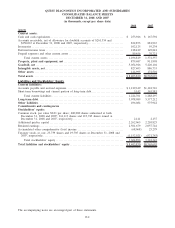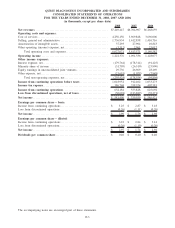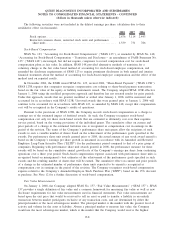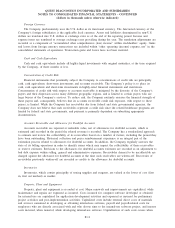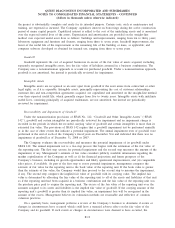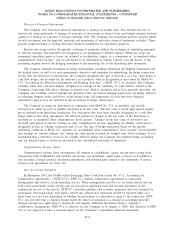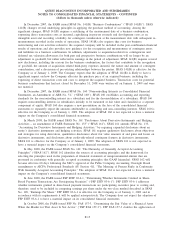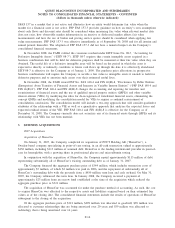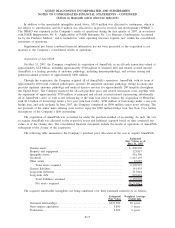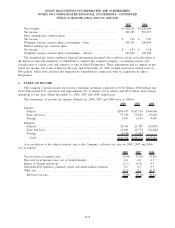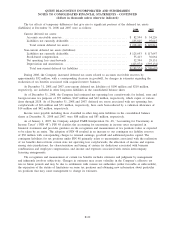Quest Diagnostics 2008 Annual Report Download - page 83
Download and view the complete annual report
Please find page 83 of the 2008 Quest Diagnostics annual report below. You can navigate through the pages in the report by either clicking on the pages listed below, or by using the keyword search tool below to find specific information within the annual report.Foreign Currency
The Company predominately uses the U.S. dollar as its functional currency. The functional currency of the
Company’s foreign subsidiaries is the applicable local currency. Assets and liabilities denominated in non-U.S.
dollars are translated into U.S. dollars at exchange rates as of the end of the reporting period. Income and
expense items are translated at average exchange rates prevailing during the year. The translation adjustments are
recorded as a component of “accumulated other comprehensive (loss) income” within stockholders’ equity. Gains
and losses from foreign currency transactions are included within “other operating (income) expense, net” in the
consolidated statements of operations. Transaction gains and losses have not been material.
Cash and Cash Equivalents
Cash and cash equivalents include all highly-liquid investments with original maturities, at the time acquired
by the Company, of three months or less.
Concentration of Credit Risk
Financial instruments that potentially subject the Company to concentrations of credit risk are principally
cash, cash equivalents, short-term investments and accounts receivable. The Company’s policy is to place its
cash, cash equivalents and short-term investments in highly-rated financial instruments and institutions.
Concentration of credit risk with respect to accounts receivable is mitigated by the diversity of the Company’s
payers and their dispersion across many different geographic regions, and is limited to certain payers who are
large buyers of the Company’s services. To reduce risk, the Company routinely assesses the financial strength of
these payers and, consequently, believes that its accounts receivable credit risk exposure, with respect to these
payers, is limited. While the Company has receivables due from federal and state governmental agencies, the
Company does not believe that such receivables represent a credit risk since the related healthcare programs are
funded by federal and state governments, and payment is primarily dependent on submitting appropriate
documentation.
Accounts Receivable and Allowance for Doubtful Accounts
Accounts receivable are reported at realizable value, net of allowances for doubtful accounts, which is
estimated and recorded in the period the related revenue is recorded. The Company has a standardized approach
to estimate and review the collectibility of its receivables based on a number of factors, including the period they
have been outstanding. Historical collection and payer reimbursement experience is an integral part of the
estimation process related to allowances for doubtful accounts. In addition, the Company regularly assesses the
state of its billing operations in order to identify issues which may impact the collectibility of these receivables
or reserve estimates. Revisions to the allowances for doubtful accounts estimates are recorded as an adjustment to
bad debt expense within selling, general and administrative expenses. Receivables deemed to be uncollectible are
charged against the allowance for doubtful accounts at the time such receivables are written-off. Recoveries of
receivables previously written-off are recorded as credits to the allowance for doubtful accounts.
Inventories
Inventories, which consist principally of testing supplies and reagents, are valued at the lower of cost (first
in, first out method) or market.
Property, Plant and Equipment
Property, plant and equipment is recorded at cost. Major renewals and improvements are capitalized, while
maintenance and repairs are expensed as incurred. Costs incurred for computer software developed or obtained
for internal use are capitalized for application development activities and expensed as incurred for preliminary
project activities and post-implementation activities. Capitalized costs include external direct costs of materials
and services consumed in developing or obtaining internal-use software, payroll and payroll-related costs for
employees who are directly associated with and who devote time to the internal-use software project, and interest
costs incurred, when material, while developing internal-use software. Capitalization of such costs ceases when
F-11
QUEST DIAGNOSTICS INCORPORATED AND SUBSIDIARIES
NOTES TO CONSOLIDATED FINANCIAL STATEMENTS - CONTINUED
(dollars in thousands unless otherwise indicated)



